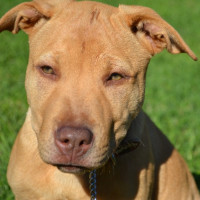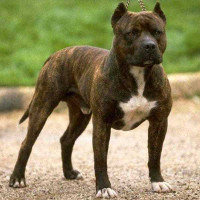Appearance of the Pit Pei
|
| Since Pit Peis are hybrid breeds, they have no specific physical standards. These dogs may resemble a cross between the Shar Pei and the American Pit Bull Terrier, or they may look more like one than the other. A Shar Pei's coat is extremely harsh, with fur that is never wavy or soft. Instead, the Shar Pei's coat is described as short, smooth and stiff, and must be solid in color. The American Pit Bull Terrier has a differently textured coat that can be patterned. The overall result of mixing these breeds will be a medium-sized dog with a medium-length coat and small legs. The eyes will be dark, as will the muzzle, which are characteristics adopted from the Shar Pei parent. The American Pit Bull Terrier can also be seen in these dogs in their stocky frame and strong jaw. Some dogs of this hybrid breed may be different from others. |
Temperament of the Pit Pei
|
| Shar Pei and American Pit Bull Terrier mixes take on personality traits from both parent breeds. Because of the two breeds used to make the Pit Pei, these dogs can be noisy and like to bark, and so may not be ideally suited to owners who live in apartments. The Shar Pei and American Pit Bull Terrier are known to be stubborn, which means the Pit Pei should be paired with a strong owner who has some experience with dogs. These dogs respond better to positive reinforcement. Since both the American Pit Bull Terrier and the Shar Pei were originally bred as fighting dogs, offspring of these breeds that are not properly bred can be aggressive towards other dogs. Both parent breeds are generally unsuitable for children, so we can expect similar behavior from the Pit Pei. Shar Pei's are quite independent and often choose to bond with just one person, whereas the American Pit Bull Terrier is more affectionate with all its inhabitants. |
Needs and activities of the Pit Pei
|
| Pit Pei dogs have parents who put on weight easily. For this reason, owners of these dogs must be careful not to overfeed their pets. Making sure they get enough exercise will also prevent them from becoming obese. These dogs enjoy all forms of exercise, but particularly like to accompany their owners on walks. However, you'll need to be careful with their thick coats when exercising them in hot weather. They'll need frequent breaks and plenty of water to keep them from overheating. These dogs are only suited to living in apartments if they get enough exercise, as they prefer to live in open homes with a yard. |
Maintenance of the Pit Pei
|
| As this designer breed generally adopts the short, fine hair of the American Pit Bull Terrier, they won't have very high grooming requirements and will only need weekly coat care. During shedding seasons, you may want to increase brushing frequency to help control shedding. They'll need to carefully clean the folds of their skin during bathing. In fact, the folds should be checked daily for any accumulation of moisture or dirt. Other needs of these dogs include brushing teeth, trimming nails and cleaning ears. Your dog's teeth need to be cleaned and maintained, just like yours, and should be brushed at least two to three times a week. Their nails should also be trimmed regularly. Depending on how fast your dog's nails grow, they should be trimmed once a month or every other month. Your dog's ears should be wiped weekly to prevent the development of ear infections. |









 English (United Kingdom)
English (United Kingdom)